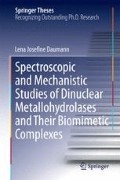Abstract
The enzyme GpdQ has been investigated previously as a potential bioremediator. However, although the enzyme was known to degrade a range of organophosphate substrates and a mechanism has been proposed, little was known about the metal ion content in vivo.
Access this chapter
Tax calculation will be finalised at checkout
Purchases are for personal use only
Reference
J.W. Chen, X.Y. Wang, Y.G. Zhu, J. Lin, X.L. Yang, Y.Z. Li, Y. Lu, Z.J. Guo, Inorg. Chem. 44, 3422–3430 (2005)
Author information
Authors and Affiliations
Corresponding author
Rights and permissions
Copyright information
© 2014 Springer International Publishing Switzerland
About this chapter
Cite this chapter
Daumann, L.J. (2014). Conclusion and Outlook. In: Spectroscopic and Mechanistic Studies of Dinuclear Metallohydrolases and Their Biomimetic Complexes. Springer Theses. Springer, Cham. https://doi.org/10.1007/978-3-319-06629-5_9
Download citation
DOI: https://doi.org/10.1007/978-3-319-06629-5_9
Published:
Publisher Name: Springer, Cham
Print ISBN: 978-3-319-06628-8
Online ISBN: 978-3-319-06629-5
eBook Packages: Chemistry and Materials ScienceChemistry and Material Science (R0)

